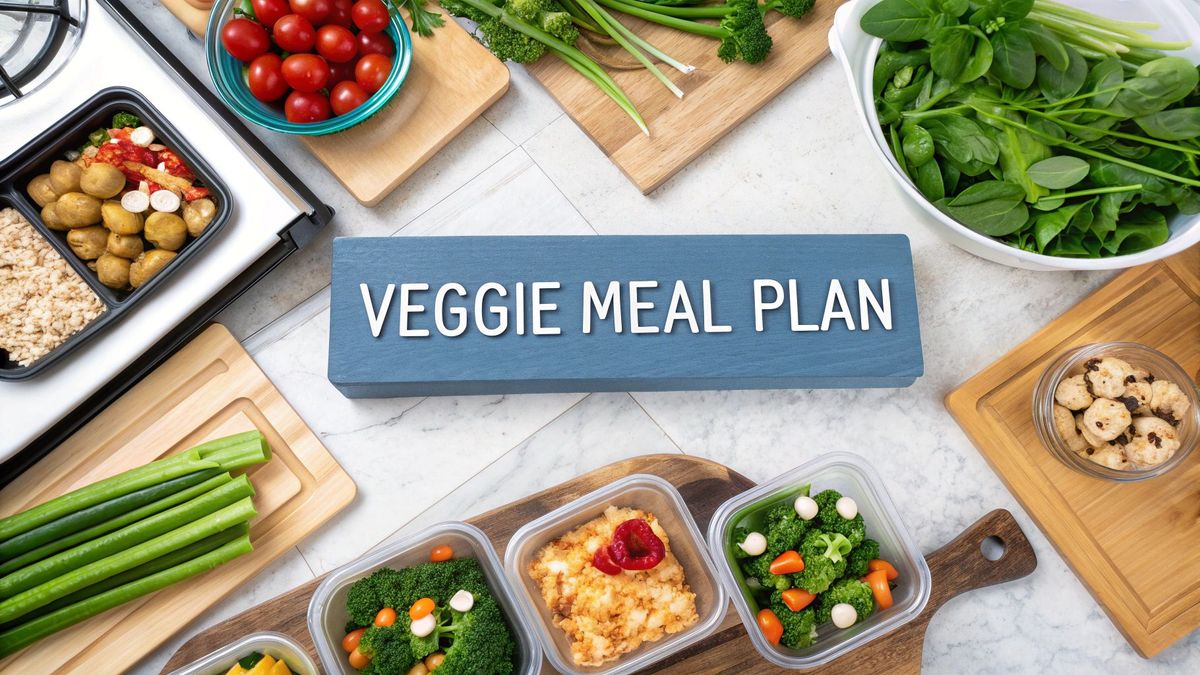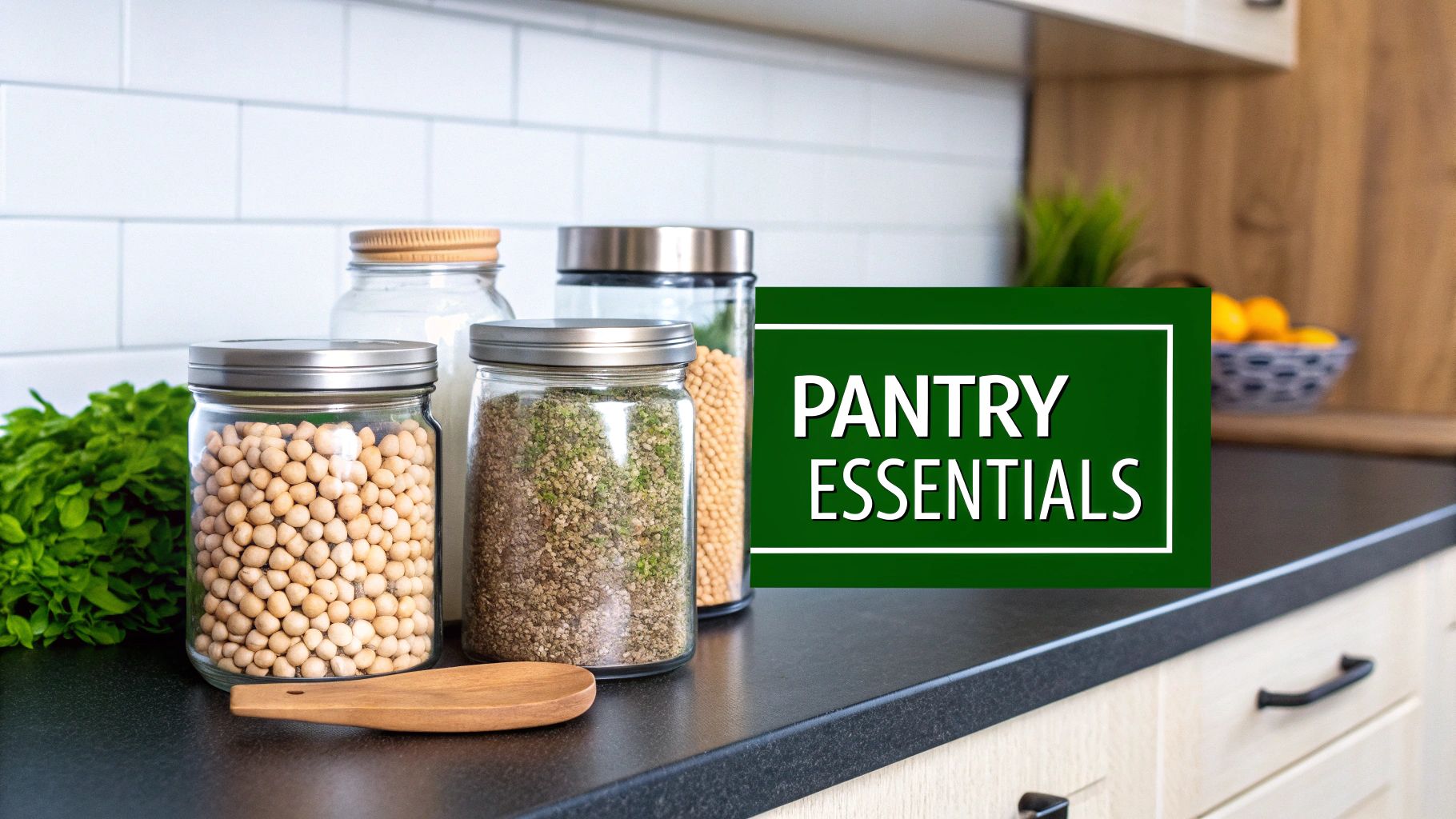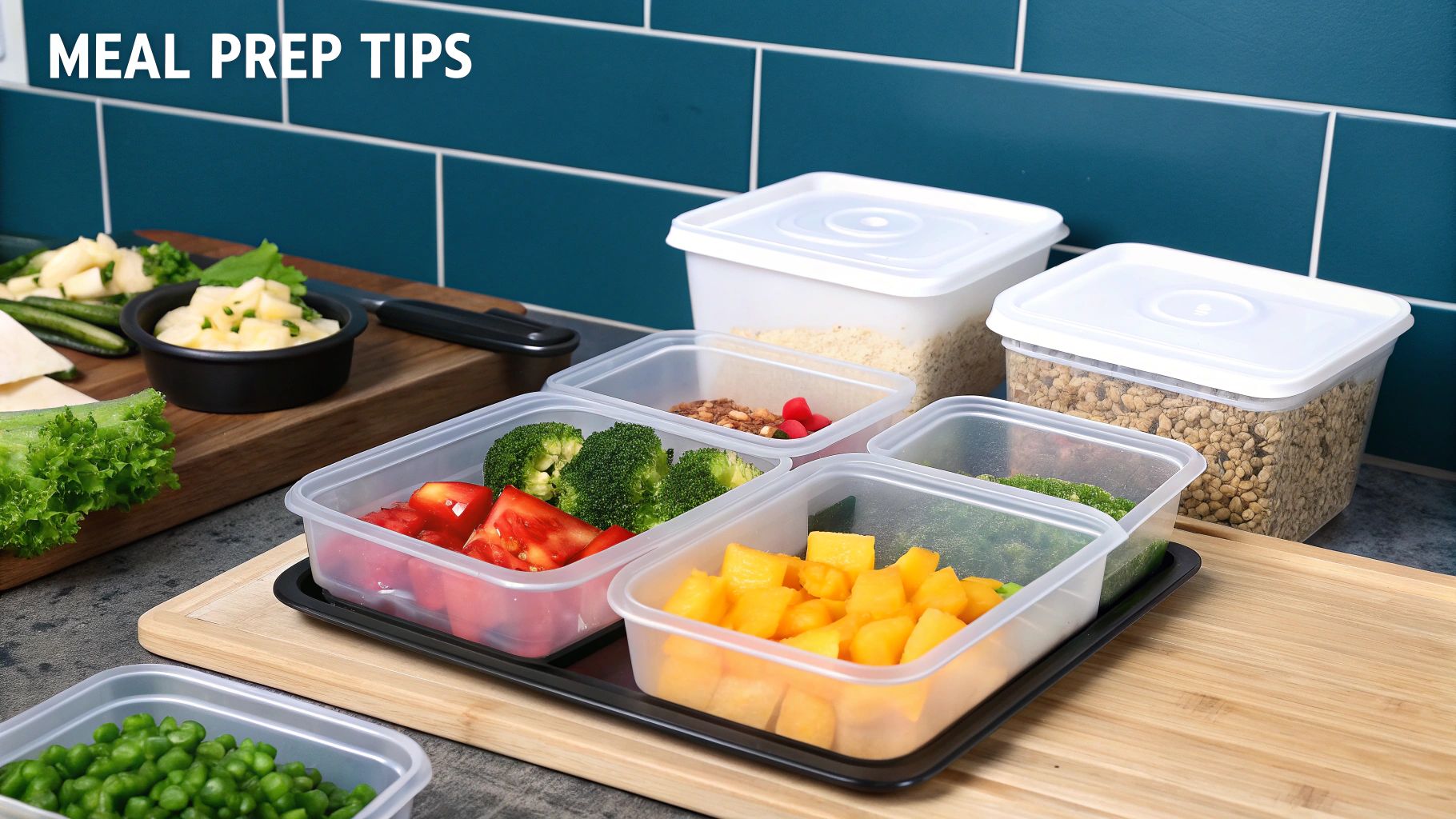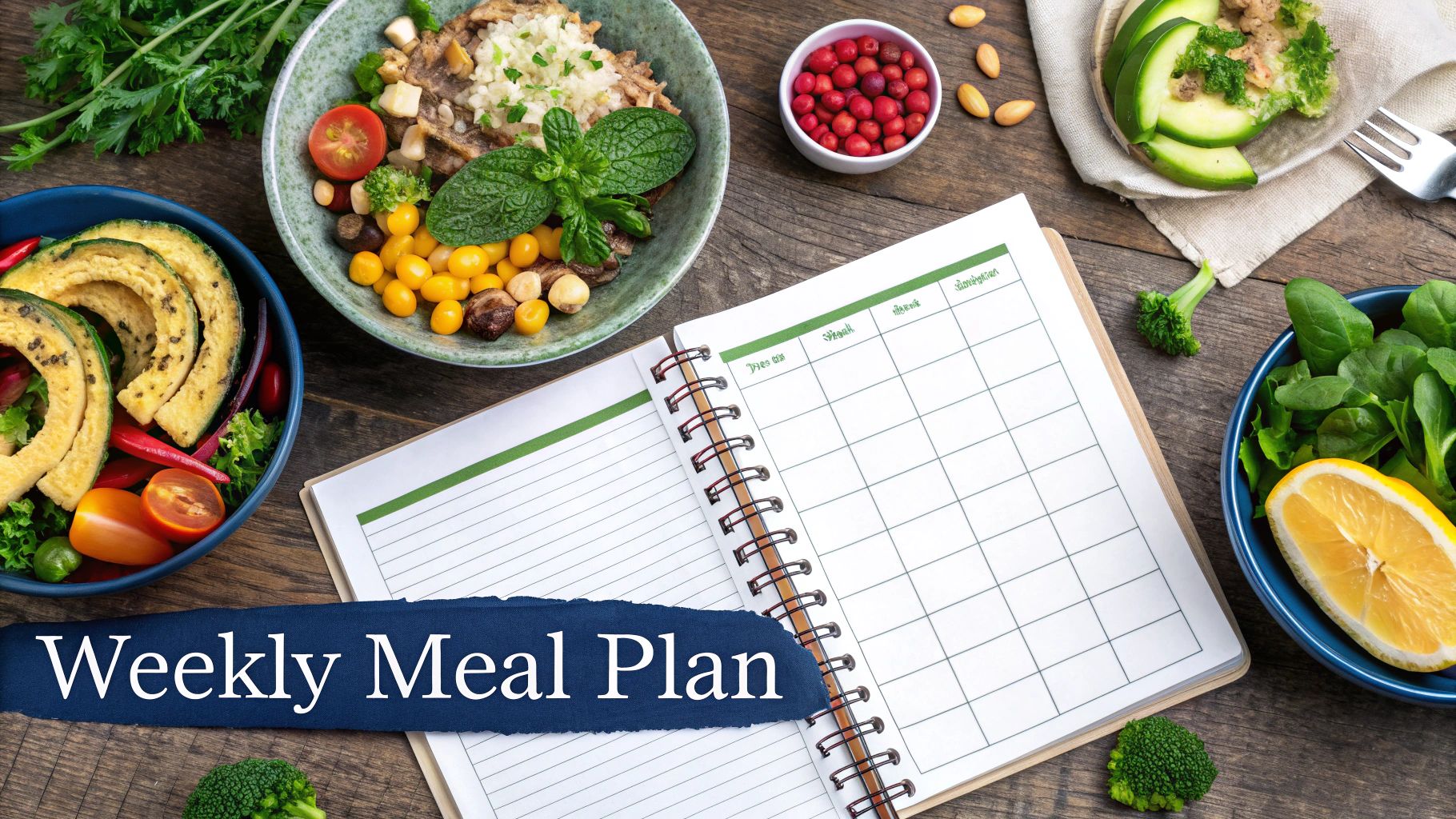Easy Vegetarian Meal Planning for the Week
Tired of takeout? Our guide to vegetarian meal planning for the week makes it simple to eat well. Get menus, lists, and tips that actually work!
Ready to Simplify Your Meal Planning?
Get personalized meal plans and grocery lists automatically matched to your macro targets.

Easy Vegetarian Meal Planning for the Week
Let’s be honest, vegetarian meal planning sounds like the kind of thing hyper-organized people do on a Sunday afternoon. But what if I told you it’s the secret weapon to reclaiming your weeknights, saving a surprising amount of cash, and finally ditching that dreaded 5 PM "what's for dinner?" panic?
It’s not about rigid schedules or complicated spreadsheets. It's a simple game plan: decide what you’ll eat ahead of time. That's it. This one small chunk of effort up front will pay you back over and over again in time, money, and your own sanity.
Why Bother with a Weekly Vegetarian Meal Plan?
I get it. The last thing you want to do on your day off is add another chore to the list. But think of it this way: this is the one chore that actually buys you back time later. It’s the key to unlocking easier evenings, a healthier plate, and a fatter wallet. We're talking about a simple, real-life system that actually sticks.
There's a massive shift happening toward plant-based eating, and for good reason. While most people say they want to eat more plant-forward meals, only about 20% of us actually pull it off consistently. This isn’t just some trend; it’s a smart move. The health and environmental perks are huge, but the cost savings alone are staggering—we’re talking a potential grocery bill drop of 21–34%. If you're curious, you can dive deeper into the data behind this growing plant-based trend.
It's a Mindset, Not Just a Menu
A good meal plan is so much more than a list of recipes. It’s a total shift in how you approach your kitchen. You’ll stop making those desperate, last-minute grocery runs for that one onion you forgot. Instead, you'll walk in with a mission, breeze past all the tempting junk, and walk out with only what you truly need.
This little bit of planning creates a fantastic ripple effect:
- You'll waste way less food. Planning lets you use that entire bag of spinach or bunch of cilantro across a few meals, instead of discovering it as a slimy science experiment in your crisper drawer a week later.
- You'll eat so much better. When a delicious, home-cooked meal is already on the docket, you’re way less likely to cave and order greasy takeout after a monster day at work.
- Cooking becomes fun again! Seriously. When you take the stressful decision-making out of the equation, you free up brain space to actually enjoy the sizzle of garlic in a pan.
The real magic of meal planning isn't some perfect, color-coded chart. It's the calm, smug feeling you get at 5 PM on a Tuesday, knowing a fantastic dinner is already sorted.
Think of this as a direct investment in your own well-being. It simplifies your day, nourishes your body, and gives you back the one thing we all need more of: time. It’s not about being perfect; it’s about making your life genuinely easier.
The Building Blocks of a Great Veggie Plate
Let's be real: nobody wants to follow a rigid, complicated food pyramid just to make dinner. The secret to crafting delicious and satisfying vegetarian meals all week isn't about memorizing complex rules. It's much simpler and, frankly, way more fun.
Think of it as learning a basic formula. Once you get the hang of it, you can stop following recipes to the letter and start improvising like a seasoned pro. It’s all about understanding the "Core Four" building blocks that make up a fantastic veggie plate. This approach turns cooking from a chore into a creative outlet, helping you balance flavors, textures, and nutrients to build meals that actually keep you full and energized.
Meet Your Meal’s Core Four
Every truly satisfying vegetarian meal has four key players working together. Get to know them, and you'll be a meal-planning wizard in no time.
- Protein Powerhouses: This is the hearty foundation that keeps you from feeling hungry an hour after you eat. We're talking about more than just tofu! Think lentils, chickpeas, black beans, edamame, and tempeh—all incredibly versatile and delicious.
- Complex Carb Champions: Forget the afternoon slump. These guys provide the slow-release energy that keeps you going. Think whole grains like quinoa, brown rice, and farro, or starchy veggies like sweet potatoes and winter squash.
- Healthy Fat Favorites: Fat isn't the enemy! It’s essential for flavor and helping your body absorb vitamins. Avocado, nuts, seeds (hello, chia and flax!), and good-quality olive oil add that rich, satisfying element that makes a meal feel complete.
- Vibrant Veggies & Fruits: This is where the magic happens. Pack your plate with color, vitamins, and minerals. Aim for a rainbow of leafy greens, crunchy bell peppers, bright broccoli, and sweet berries.
When you bring these elements together, you're not just making a meal; you're setting yourself up for a week of success.

As you can see, a balanced plate does more than just taste good—it fuels better health, which ultimately saves you time and money. It's a pretty sweet deal.
Putting It All Together
Now for the fun part: mixing and matching. Let's say you prepped a big batch of quinoa (your carb) and roasted some broccoli and bell peppers (your veggies) over the weekend. For a lightning-fast lunch, just toss those with a can of chickpeas (protein!) and a creamy tahini dressing (healthy fat). Boom. Done.
The goal isn't just to fill a plate; it's to create a balanced meal that works for you. By stocking your kitchen with a variety of these Core Four ingredients, you empower yourself to build delicious meals on the fly, no recipe required.
This simple mix-and-match system is the heart of effective vegetarian meal planning for the week. It completely removes the pressure of having to hunt down a new, complicated recipe for every single meal.
Instead, you’ve got a toolkit of versatile ingredients ready to go. You can assemble something nourishing and tasty in minutes, which is a lifesaver on busy weeknights. When you pair this flexible system with smart tools like Meal Flow AI, your grocery shopping and weekly prep become almost effortless.
Here's a quick cheat sheet to get your creative juices flowing. Think of this table as your personal meal-building playbook. Just pick one or two items from each column, and you've got a balanced, delicious meal in the making.
Mix-and-Match Meal Building Blocks
| Protein Powerhouses | Complex Carb Champions | Healthy Fat Favorites | Vibrant Veggies & Fruits |
| Lentils (brown, green, red) | Quinoa | Avocado | Spinach & Kale |
| Chickpeas (canned or dry) | Brown Rice | Nuts (almonds, walnuts) | Bell Peppers (any color) |
| Black Beans | Sweet Potatoes | Seeds (chia, flax, pumpkin) | Broccoli & Cauliflower |
| Tofu & Tempeh | Whole-Wheat Pasta | Olive Oil | Berries & Apples |
| Edamame | Farro or Barley | Tahini | Tomatoes & Cucumbers |
With these building blocks at your fingertips, you're no longer just cooking; you're creating. You have the freedom to build meals that fit your cravings and your schedule, making healthy eating feel less like a rulebook and more like an adventure.
Your Foolproof 5-Day Vegetarian Meal Plan

Alright, enough with the theory. Let's roll up our sleeves and see what a realistic, delicious, and genuinely easy week of vegetarian eating actually looks like. Think of this less as a strict diet plan and more as a flexible blueprint for real life—you know, the kind where time is short and cravings are very, very real.
The focus here is on meals that are a breeze to assemble, taste even better as leftovers, and cleverly share ingredients. This is the secret sauce of smart vegetarian meal planning for the week: making every single thing you buy work twice as hard.
And honestly, there's never been a better time to dive in. The plant-based movement isn't just a trend; it's a massive shift. Around 1.5 billion people worldwide eat a vegetarian diet, and here in the U.S., the plant-based food market shot past a whopping $8 billion in 2022. That explosion means we have more and better options on grocery store shelves than ever before. If you're curious, you can dig into some more of these wild vegetarian population statistics yourself.
A Sample Week of Delicious Simplicity
Here’s a peek at a 5-day plan that’s all about big flavor and zero fuss. Pay close attention to how ingredients from one day pop up in another—that’s the magic.
Monday: One-Pan Roasted Gnocchi with Veggies
- Why it works: Because who has time for dishes? Tossing store-bought gnocchi, cherry tomatoes, broccoli, and a can of cannellini beans onto a single sheet pan is a total game-changer. Drizzle with olive oil, sprinkle some Italian seasoning, and bam—dinner's on the table in 25 minutes.
Tuesday: Speedy Lentil Wraps with Avocado
- Why it works: This is the ultimate 15-minute meal. Grab some pre-cooked or canned lentils, stir in a spoonful of salsa and a dash of cumin, and roll it all up in a whole-wheat tortilla. Smash in some avocado, a handful of spinach, and toss in any leftover roasted veggies from Monday night. It’s packed with protein and will actually keep you full.
Wednesday: Creamy Tomato Soup & Grilled Cheese
- Why it works: Sometimes you just need comfort food. A simple can of tomato soup gets an incredible upgrade with a splash of coconut milk for creaminess. Pair it with a classic grilled cheese on good, grainy bread. It’s a hug in a bowl, and perfect for a hectic Wednesday.
The secret to a meal plan you'll actually stick with is building in some wiggle room. Not feeling soup on Wednesday? No problem. Swap it with Thursday’s chili. This is your plan—make it work for you.
Thursday: Hearty Black Bean & Sweet Potato Chili
- Why it works: This is my favorite kind of "dump-and-go" dinner. Sauté an onion and some garlic, then just dump in canned black beans, diced tomatoes, a cubed sweet potato, and your chili spices. Let it simmer away, and you’ve got a fantastic dinner with guaranteed leftovers for Friday’s lunch. Bonus: This chili freezes like a dream.
Friday: DIY Veggie Pizza Night
- Why it works: Let's end the week with something fun! Grab some store-bought pizza dough or even naan bread for mini pizzas. Set out bowls of leftover chili (trust me on this), canned corn, sliced bell peppers, onions, and cheese. Everyone gets to build their own masterpiece. Easy, interactive, and a certified crowd-pleaser.
Clever Ingredient Crossovers
The real beauty of this plan isn't just the individual meals; it's how they talk to each other. This is how you shrink your shopping list and cut down on waste.
- Sweet Potatoes: The hero of Thursday’s chili? You can chop it up and roast it right alongside Monday’s gnocchi to get ahead.
- Onions & Bell Peppers: These kitchen workhorses show up in the chili and then again as pizza toppings on Friday.
- Canned Goods: Leaning on your pantry MVPs—canned beans, lentils, and tomatoes—is the key to making every meal come together in a flash.
This whole approach isn't just about saving time. It's about saving your sanity. When you have a simple, delicious plan ready to go, you free up so much mental energy for everything else life throws at you. And you get to eat amazing food while you're at it.
Getting Your Grocery Game On Point

Okay, you've got a brilliant meal plan. High five! But let's be real—it's just a pretty piece of paper until you have the actual food in your kitchen. This is where the magic really happens. A solid, organized grocery list is the unsung hero of a chill week, turning a chaotic store run into a quick, surgical strike that saves you cash and sanity.
Think of it as your secret weapon against those sneaky impulse buys and the maddening "oh crap, I forgot the onion" trip back to the store.
Your first move, and this is non-negotiable, is what I call the pantry-first audit. Before you even dream of writing a list, you must take stock of what you already have. Seriously. Pop open the fridge, peek in the freezer, and scan your pantry shelves.
That half-bag of quinoa, that lonely can of black beans, the frozen spinach you bought three weeks ago? That's not clutter; that's your starting lineup! This little habit ensures you use what you’ve got, which is a killer way to slash food waste and your grocery bill. You'll be amazed at how many ingredients are already hiding in plain sight.
The Aisle-by-Aisle Attack Plan
Once you know what you're working with, it's time to build your list. But here's the trick: stop scribbling down a random jumble of words. The real pro move is to organize your list by the store's layout. Think produce, dairy, canned goods, grains... you get the picture. This tiny shift in strategy stops you from zigzagging through the aisles like a confused pinball.
Here's a simple way to break it down:
- Produce Power: This is for all your fresh stuff. Leafy greens, hearty root veggies, and those all-important aromatics like onions and garlic.
- Pantry Staples: Canned goods (tomatoes, beans, lentils), grains (rice, pasta, quinoa), and any baking needs go here.
- Fridge & Freezer Finds: Group your tofu, tempeh, non-dairy milks, yogurts, and any frozen fruits or veggies together.
- Flavor Boosters: Don't forget the little things that make a big difference—spices, fresh herbs, oils, and sauces.
A quick word on frozen food: it is not a dirty word! Frozen produce is picked at its absolute peak, making it just as nutritious (and often cheaper) than fresh. It's a lifesaver for things like berries, corn, and peas.
Stocking Up for Spontaneous Deliciousness
A well-stocked kitchen is the secret to making this whole meal-planning thing feel effortless. Some ingredients are just so darn versatile they deserve a permanent spot on your shelf. With these on hand, a tasty meal is never more than a few minutes away.
My personal ride-or-die vegetarian staples are:
- Canned Beans: Chickpeas, black beans, and cannellini beans are protein-packed heroes.
- Versatile Grains: Quinoa, brown rice, and oats can be the foundation for a thousand different meals.
- Long-Lasting Produce: You can't go wrong with onions, garlic, potatoes, and sweet potatoes. They'll hang around for ages.
- Quality Oils & Vinegars: A good olive oil and a splash of balsamic can make just about anything taste better.
Adopting this approach turns grocery shopping from a total chore into a key part of your vegetarian meal planning for the week. And hey, if you want to make life even easier, tools like Meal Flow AI can automatically spit out a shopping list from your meal plan and even send it over to Instacart. It’s pretty much like having a personal kitchen assistant.
Time-Saving Kitchen Hacks for Meal Prep Success

Look, you don’t need to chain yourself to the stove all Sunday just to eat well during the week. That’s a myth. The real secret to a killer vegetarian meal plan isn't about logging more hours in the kitchen—it's about making those hours count. It's about working smarter, not harder, with a few clever tricks up your sleeve.
Let me introduce you to the magic of "component prepping." Instead of painstakingly making five entirely different meals, you prepare a bunch of versatile ingredients that you can mix and match on the fly. Think of it as building your own personal, high-quality salad bar right inside your fridge.
And you're not alone in wanting this. People are desperate for easy plant-based options. Get this: searches for 'vegan food near me' shot up by over 5,000% back in 2021. Component prepping is your way of creating that same convenience at home, but way healthier and cheaper. You can even see the stats on the global rise of plant-based eating to understand just how massive this shift is.
Component Prepping is Your New Best Friend
Forget the idea of cooking entire recipes from scratch on Sunday. Your new weekend ritual is all about the building blocks. This tiny mindset shift is what unlocks ridiculously fast meals on a chaotic Tuesday night.
So, what does a component prep session actually look like? It’s simple.
- Get Your Grains On: Cook up a big pot of quinoa, brown rice, or farro. Once it’s cool, you’ve got the base for grain bowls, salads, and burrito fillings ready to go.
- Roast a Sheet Pan of Veggies: Toss hearty vegetables like broccoli, sweet potatoes, and bell peppers with a little olive oil and seasoning, then roast 'em up. Done.
- Pick Your Protein: Hard-boil half a dozen eggs. Press a block of tofu so it's ready for a quick pan-fry. Cook up a batch of lentils. Whatever your go-to is, get it ready.
- Whip Up a Killer Dressing: Whisk together a simple lemon-tahini or a classic balsamic vinaigrette. A fantastic homemade dressing can make even the simplest ingredients sing.
With these pieces ready and waiting, throwing together a healthy dinner becomes a 5-minute job, not a 45-minute chore.
Nail Your Food Storage Game
All that brilliant prep work means nothing if your food goes bad by Tuesday. Seriously, there's nothing more soul-crushing than finding your beautifully chopped veggies have turned to slime.
The whole point here is to make "future you" happy. Proper food storage is the ultimate gift you give yourself, making sure your hard work actually pays off with fresh, delicious meals.
Here are a few tricks I swear by:
- Save Your Greens: Wash and thoroughly dry your leafy greens. I'm talking bone-dry. Then, store them in a container lined with a paper towel. This little trick easily doubles their lifespan.
- Beat the Brown Avocado: To keep a cut avocado green, leave the pit in, give the flesh a quick brush with lemon juice or olive oil, and wrap it up tight.
- Keep Herbs Fresh: Treat fresh herbs like a little bouquet of flowers. Just pop them stem-down in a jar with a bit of water and stick them in the fridge.
These aren't just random tips; they're the habits that make vegetarian meal planning for the week feel genuinely easy. Turn these hacks into a routine, and you’ll finally conquer the meal prep chaos for good.
Got Questions About Vegetarian Meal Planning? You're Not Alone.
Jumping into weekly vegetarian meal planning can feel a little daunting. It's totally normal to have a few questions swirling around before you dive in. Let's clear up some of the most common worries I hear so you can get started with confidence.
First up, the big one: protein. Everyone immediately worries about where their protein will come from. But honestly, it's way less complicated than most people think. You don't need to be chugging protein shakes or eating a whole block of tofu three times a day.
The secret is to just pepper your day with little protein boosts. Think a sprinkle of hemp seeds on your oatmeal, a handful of chickpeas tossed into your salad at lunch, or a hearty lentil soup for dinner. It all adds up, keeping you full and satisfied without any complicated math.
But What If I'm Cooking for a Picky Eater?
Ah, the classic dilemma. Whether it's your spouse, your kids, or hey, even yourself, catering to different tastes can feel like a part-time job. The solution isn't to start your own personal restaurant every night. It's all about building meals with customizable parts.
I'm a huge fan of the "build-your-own" approach. Tacos, bowls, and pasta bars are your best friends here. You provide the foundation—like rice, quinoa, or pasta—and then lay out a spread of toppings.
- Protein options: A bowl of seasoned black beans and some crumbled feta cheese.
- Veggies galore: Diced bell peppers, cherry tomatoes, and some roasted sweet potatoes.
- Sauces and extras: A simple salsa, a dollop of Greek yogurt or sour cream, and some avocado.
This strategy is a game-changer. It turns dinner from a potential argument into a fun, hands-on activity. Everyone feels in control, everyone gets what they like, and you only had to prep a few simple components. Win-win.
Remember, a meal plan is a tool, not a trap. The goal is to make your life easier. If you have to swap a dinner for "scrambled eggs on toast" one night because you're exhausted, that's not a failure. That's called being a human.
And finally, do you need to stock your pantry with a bunch of weird, expensive ingredients? Absolutely not. Some of the best, most satisfying vegetarian meals are built on the cheapest things in the grocery store. We're talking about lentils, beans, oats, potatoes, and whatever veggies are in season. These are the real MVPs of a smart, affordable menu.
---
Ready to make this whole process ridiculously easy? Meal Flow AI does the heavy lifting for you. Our tool whips up personalized vegetarian meal plans and creates a shopping list you can send right over to Instacart. Check it out and take back your weeknights at https://mealflow.ai.